Annual Conference Primer
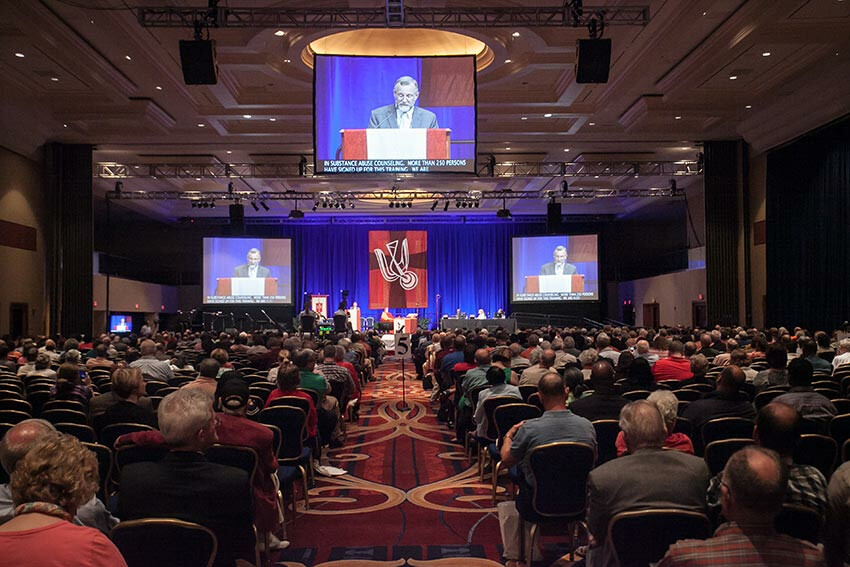
Guide for First-Time Lay Members to the Baltimore-Washington Conference
By Erik Alsgaard
BWC Communications Staff
There are 132 annual conferences around the world, with 54 in the United States. The Baltimore-Washington Conference, in the Northeastern Jurisdiction, is led by Bishop LaTrelle Easterling, who was elected as a bishop at the Northeastern Jurisdictional Conference in 2016. Bishops often serve for two consecutive four-year terms. Our conference has 613 churches or charges and approximately 150,000 members. Bishop Easterling presides over the Annual Conference Session but, as in the General Conference, does not vote
The BWC offices are located at 11711 East Market Place, Fulton, MD 20759-2594, in the Maple Lawn community of Howard County. Conference staff includes the bishop; eight district superintendents and their respective district administrators; several program or discipleship staff; and financial/operations and communications staff. Altogether, there are about 50 people on the conference staff.
The Baltimore-Washington Conference is made up of regions and districts. The BWC has four regions, and each region has two districts, presided over by a district superintendent.
Annapolis Southern Region
Annapolis District – Rev. Rebecca Iannicelli
Washington East District – Rev. Johnsie Cogman
Baltimore Region
Baltimore Metropolitan – Rev. Wanda Duckett
Baltimore Suburban – Rev. Ann Laprade
Washington Region
Central Maryland – Rev. JW Park
Greater Washington – Rev. Gerry Green
Western Region
Cumberland-Hagerstown – Rev. John Wunderlich
Frederick – Rev. Edgardo Rivera
Each local church and charge belongs to a district. Most churches or charges (two or more churches with one pastor) are presided over by either an ordained Elder or a probationary Elder; some smaller congregations are served by local pastors or student pastors.
Who are members of annual conference?
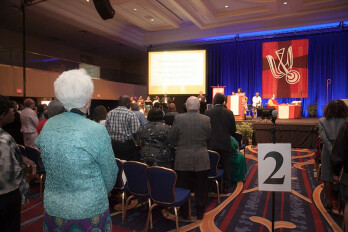 All clergy (Elders and Deacons) hold their membership in the Annual Conference, not in a local church. Deaconesses and Diaconal ministers, both retired and active, are lay members of Annual Conference. The Book of Discipline requires an equal number of laity and clergy to be members of the Annual Conference Session. To be a voting member, a lay person must be elected by his or her local church through a nomination and voting process that is held at the annual Charge Conference.
All clergy (Elders and Deacons) hold their membership in the Annual Conference, not in a local church. Deaconesses and Diaconal ministers, both retired and active, are lay members of Annual Conference. The Book of Discipline requires an equal number of laity and clergy to be members of the Annual Conference Session. To be a voting member, a lay person must be elected by his or her local church through a nomination and voting process that is held at the annual Charge Conference.
The Charge Conference is to the local church what the Annual Conference Session is to the Conference; i.e., the annual business meeting. Charge Conferences may happen more often, but they must happen at least once a year, under the rules of the Book of Discipline. A district superintendent or her/his designee presides. The laity
236th SESSION OF THE BALTIMORE-WASHINGTON CONFERENCE - 2020
Theme: “We Are One: Going Out in Mission”
The Annual Conference Session is presided over by Bishop LaTrelle Easterling, who is the legal chairperson of the Annual Conference. Other officers include the Conference Secretary (Kevin Silberzahn), elected for a four-year term at the beginning of the quadrennium; the Conference Treasurer (Paul Eichelberger); the Conference Lay Leader (Delores Martin); and the Chancellor (Thomas Starnes). The bishop’s decisions must conform to the Rules of Order. Under our rules, during
What is the business of Annual Conference Session?
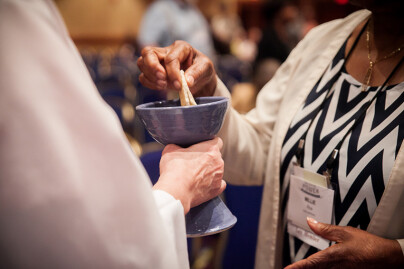 This year, members will be called upon to vote on several items including the 2021 annual budget and several resolutions, which will be presented on the conference website.
This year, members will be called upon to vote on several items including the 2021 annual budget and several resolutions, which will be presented on the conference website.
This year, we will also be responding to the work of the 2020 General Conference, which was held in Minneapolis, Minn. May 5-15
Annual Conference also includes many opportunities for inspirational worship, reports from the Discipleship and Stewardship areas of the conference; a memorial service recognizing
Who can vote and how do I vote?
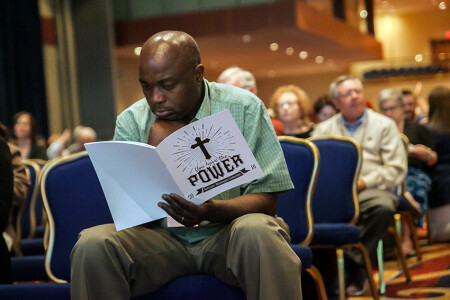
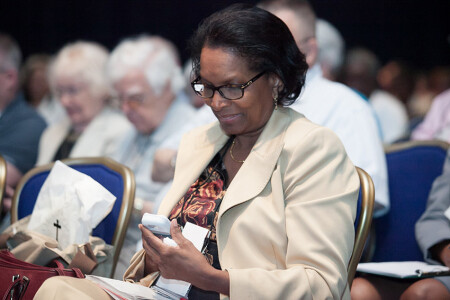
When you register, you are given a packet of materials, a name tag and a voting card that has a color-coded ribbon attached according to various categories. Laity cards have white ribbons. A reserve lay member has a green ribbon. Full clergy members, both Elders
Early in the conference schedule, the bishop declares the boundaries of the bar. People who are not allowed to vote, i.e. guests and friends, staff and a few others, must sit “outside the bar.” To be eligible and able to vote, you must sit “inside the bar.” Marshalls and ushers monitor the doors carefully and direct people, according to the color of their badge ribbon, to the proper sections. Lay members vote. Clergy vote. Guests do not.
Any voter may speak from the floor to a motion, but no one person may speak more than twice on any given motion. The bishop controls who speaks, establishing that there can be three for and three against the motion before
Reserve members, elected by each church, can only vote when they are substituting for the Lay Member and have officially been recognized by the Conference Secretary. Reserves may attend to hear the debate and procedures, but may not vote.
Someone speaking to a motion is asked to give his or her name and their church before beginning to speak to only one issue. If proposing an amendment, the speaker is asked to write out a statement and give a copy to the secretaries who are sitting in the front of the ballroom to assure that the words are recorded properly. The bishop tries to honor all sections of the room and to not let either gender dominate. Young people may get precedence.
Any member may “move for the question,” which takes precedence over the debate going on. It requires two-thirds agreement. The Annual Conference Session follows its own “Rules of the Session.” In any parliamentary situation not clearly covered by the Rules of the Session, the Conference is governed in its actions by the current edition of Robert’s Rules of Order.
Sometimes I don’t understand what is meant. Can you help?
Here is a list of “jargon,” words that we United Methodists use without thinking, but with which someone new to the process might have trouble. It’s in alphabetical order for easy reference.
Mission Shares and benevolence factor: Every church is expected to pay its Mission Shares (formerly known as apportionments), the share of the overall expenses of running a large denomination, jurisdiction, annual conference and district. Mission Shares financially underwrite United Methodist ministry and mission beyond the local church. The amount for each church is reached by a specific formula, called the benevolence factor. In 2020, the benevolence factor will be 17.6 percent of the local church’s operating budget. Expenses a church has for building construction or to support missions is not counted as operating budget. Church treasurers are very aware of what the calculations include. By operating on a percentage basis, smaller churches pay fewer dollars than larger churches.
The Book of Discipline or simply the Discipline: This is the official manual of procedures and regulations. It covers every aspect of church life, doctrine, guidance for Christian behavior, procedures for becoming a church member or minister, protocols for organizing and administering local churches, annual conferences, districts
Book of Resolutions: This book explains the many social and justice ministries’ actions that The United Methodist Church believes in, teaches, and practices. It contains all resolutions or pronouncements on issues approved by the General Conference and currently valid.
Cabinet: The Appointive Cabinet includes the bishop and eight district superintendents. In addition, the Extended Cabinet includes the Director of Communications, the Director of Connectional Ministries, the Treasurer, the Director of Pensions, the Assistant to the Bishop and episcopal office staff.
Central Conference: This refers to the seven geographic areas of Africa, Europe
Charge Conference: The basic policy-making body of the local church. It reviews the congregation’s ministries, endorses candidates for ministry and sets clergy compensation.
Connectional: You often hear this word used, as in “We’re a connectional church.” It’s unique to The United Methodist Church and simply means all United Methodist leaders and congregations throughout the world are connected by certain loyalties and commitments that call us to live in covenantal accountability. “Connectionalism” empowers us to be in ministry around the world and our relationships are on equal footing, not one dominating over another.
Connectional Table: This is a Baltimore-Washington Conference program body that discusses the budget, resolutions
Deacon: A person ordained to
District:
Elder: A person ordained to a lifetime ministry of service, Word, sacrament
Local Pastor: A licensed pastor, annually approved by the District Committee on Ordained Ministry, who is authorized to perform all duties of an ordained minister while assigned to a particular church or charge under the supervision of a district superintendent.
Provisional or Probationary Elder or Deacon: In the process toward ordination for either Deacons or Elders, there is a three-year period that is somewhat like an internship. He or she serves in a church as its leader or in an associate position, studies,
Social Principles: A document setting forth the basic position of The United Methodist Church on important social issues. Each General Conference reviews the Social Principles document, makes
What if I have questions?
 You’ll find all staff friendly and willing to help; if the person you ask doesn’t have the answer, he or she can probably point to someone who does. Here are some specific ones to contact:
You’ll find all staff friendly and willing to help; if the person you ask doesn’t have the answer, he or she can probably point to someone who does. Here are some specific ones to contact:
Highlighters: Those volunteers in neon vests will point you to where you need to go, where the meetings, lunches, celebrations, exhibit room and prayer room are. That’s their job. If they don’t know the answer, they’ll direct you to someone who does.
Business office: With questions of membership and who can vote, or questions of payments, go to the business office.
Ushers and marshals: The ushers and marshals can help with questions dealing with the seating in the ballroom, who can vote, etc.
Communications and press office: For questions dealing with the public, the videos being seen, subscriptions and the Daily Connection, go to the communications office.
UMConnection Daily: Read the daily newsletter produced by the Communications office and available by 8 a.m. each day. It includes the calendar for the day with the latest information, review of legislation passed (or turned down),
Website: The conference Website is at www.bwcumc.org. A summary of the actions of
Information on the General Church
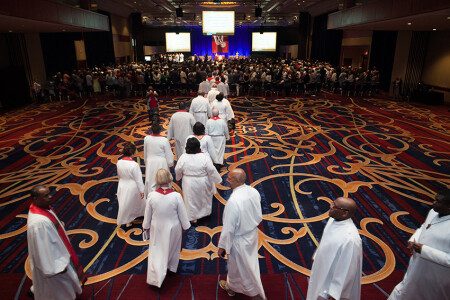
The United Methodist Church had 7,067,162 full members in the United States at the end of 2015, and 5,525,924 full members in 2013 in the Central Conferences (Conferences located outside the United States). This does not include the more than 61,000
The United Methodist Church was formed in 1968 with the union of the Evangelical United Brethren (thus the “United”) and Methodist Episcopal churches. There is no single central office, no archbishop and no pope.
The governance of The United Methodist Church is made up of four levels:
The General Conference: The United Methodist General Conference meets every four years, with no fewer than 600, nor more than 1,000 delegates. Its last regularly scheduled meeting was May 5-15. At the General Conference session, delegates from all over the world voted on many items which then amend and add to the Book of Discipline and the Book of Resolutions. The General Conference might be compared to the legislative branch of the U.S. government. The General Conference is the only official voice of The United Methodist Church. Though bishops preside over the General Conference, they have no vote.
The Baltimore-Washington Conference had six clergy and six laity delegates elected to the 2020 General Conference during the Annual Conference Session in 2019. BWC also had six alternates. Those 12 delegates became the first 12 people elected to the Jurisdictional Conference delegation. In addition, six
Working with the General Conference is the Council of Bishops, 164 active and retired bishops from all over the world, who meet somewhat like the executive branch of the U.S. government. Currently, the U.S. has 46 bishops who administer 56 annual conferences. They elect their own leader each quadrennium. The head of the Council of Bishops at present (2019-2020) is Bishop Ken Carter, who serves the Florida Area. In Africa, Europe, and the Philippines are 20 bishops administering 74 annual conferences, varying a great deal in geographic size and membership.
As the denomination’s “Supreme Court,” a nine-member Judicial Council composed of both laity and clergy, interprets church law and determines
The next largest body is the Jurisdictional Conference. There are five jurisdictions in the United States: Northeastern, North Central, Southeastern, South Central and Western. The Baltimore-Washington Conference is one of 10 conferences (9 bishops) that belong to the Northeastern Jurisdiction. The Jurisdictional Conference meets every four years following the General Conference; its primary function is to elect bishops. It also conducts
Keep up to date with Conference news and announcements. Subscribe to the
